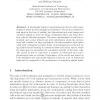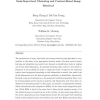688 search results - page 98 / 138 » Using reinforcement learning to adapt an imitation task |
MIRRORBOT
2005
Springer
14 years 1 months ago
2005
Springer
Abstract. A biologically inspired computational model of rodent representation–based (locale) navigation is presented. The model combines visual input in the form of realistic tw...
NN
1998
Springer
13 years 7 months ago
1998
Springer
We experimented on task-level robot learning based on bi-directional theory. The via-point representation was used for ‘learning by watching’. In our previous work, we had a r...
QRE
2010
2010
Improving quality of prediction in highly dynamic environments using approximate dynamic programming
13 years 6 months ago
In many applications, decision making under uncertainty often involves two steps- prediction of a certain quality parameter or indicator of the system under study and the subseque...
CCS
2010
ACM
13 years 8 months ago
2010
ACM
The need for network stability and reliability has led to the growth of autonomic networks [2] that can provide more stable and more reliable communications via on-line measuremen...
PR
2006
13 years 7 months ago
2006
The performance of many supervised and unsupervised learning algorithms is very sensitive to the choice of an appropriate distance metric. Previous work in metric learning and ada...


